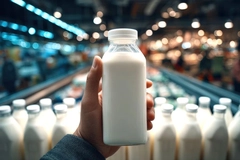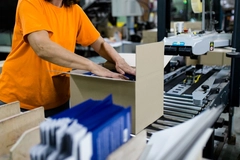Food: Signals from the Packing

Consumers give more and more thought to the safety and origin of food and increasingly look to preservation and refrigeration technologies.
MAP (Modified Atmosphere Packaging) is gaining increasing importance for fresh food. Today, convenience food in carton trays, deep-drawn plastic trays or stand-up pouches can be heated directly in the microwave or even fried until crunchy. Developments in the machinery market for this growing segment are geared to packing production, filling, controlling or marking and labelling. Labels here not only perform the task of advertising “substrates” but also serve to identify and control the goods in the flow of materials.
Consumers give more and more thought to the safety and origin of food and increasingly look to preservation and refrigeration technologies. Furthermore, their expectations concerning the retention of taste and quality have risen. Increased safety is ensured by the proof of origin of food, for example. To this end processing machines must be equipped with labelling and control equipment. New safety standards require the increasing use of software-based food processing lines. The development of variable-to-use processing and packaging lines will grow in importance since consumers’ taste is constantly changing and they demand variation time and again.
The market for functional food, i.e. products with a targeted health benefit and nutritional additives, is experiencing steady growth. A healthy diet has come to be the most important criterion for product developments in the food sector. No wonder a Swiss food group is currently being transformed into a wellness company. For this purpose their existing portfolio is undergoing a sifting process with the aim of “upgrading” products with an added nutritional benefit. Numerous new products are entering the market because target groups are changing. In future, for instance, there will be a growing share of older people who are increasingly interested in a healthy diet.
The key features for films used for packaging food are appearance, peel properties and resealability. Elaborate prints will become possible on virtually all surfaces.
Washed and cut green salads which only need a dressing to be added are growth market. For products like these solutions like films with built-in anti-fog properties have been developed. Such films prevent condensation forming on the inside of the package thereby ensuring the wrapped product retains its original appearance. One manufacturer now offers a film that can be hot sealed on both sides and comprises a printable outside, an anti-fog inside and, above and beyond, ensures excellent machinery output.
The same producer also launched new films for the bakery, cookie and confectionary industry. They captivate buyers with an extraordinary “white” colour that prevents fat from shining through thereby improving the overall looks of the package on the shelf.
Innovative biodegradable films even combine a very wide hot-sealing temperature range with improved machine speeds without loosing their sealing properties.
When using non-metal barrier-layer films the package content is only tested for metallic residuals in the finished, packaged product. This streamlines the production process and increases product safety at the same time. This advantage over conventional aluminium packages is highly appreciated, above all by herb and spice processors. All the more as this film can be processed on conventonal machines. Non-metal barrier-layer films also safely protect the aroma of marinades, coffee and fresh bakery produce such as baguettes and other bread products.
The natural colour of a packaged product is a decisive driver for many consumers to buy. This is why the vacuum applied to pre-packaged meat is increasingly replaced by inert gas. Since for vacuum-packed food the atmosphere is almost entirely evacuated meat loses its natural colours after a short time. When applying inert gas instead it retains its “taste-promising” appearance since the gas mixture contains a specific oxygen content alongside the supporting carbon dioxide and nitrogen.
New gassing systems can also extend the potential shelf life of pre-packaged food. Just as remarkable are the potential energy savings and maintenance cost cuts obtained by no longer requiring vacuum pumps.
Packaging systems for fresh food with a product claim of a healthy and easy-to-prepare meal are the latest version of the convenience trend. The latest products include a microwave-fit tray with integral humidity path for the efficient pressure cooking of instant meals. The rigid inlay which is moisturised by the food processor during the packaging process serves as a source of humidity here to generate vapour. In conjunction with a barrier top film this tray is ideally suited as a MAP. A defined opening in the top film controls excess pressure during the cooking process. It is closed with a self-adhesive label to be removed by the consumer immediately before cooking their meal in the microwave.
This tray can be used for all standard tray sealing machines; the only prerequisite being the corresponding tools (moisturiser plus puncturing and labelling device). The system is suitable for integration into a fully automatic packaging line.
The market for thermoformed packages has started to develop. Cups and trays have experienced substantial growth in the food segment. Deep-drawn trays or menu bowls are designed to meet the specific product needs. Packaging has to withstand a wide variety of stresses. It is sterilised, chilled or deep frozen and subsequently heated in a conventional or microwave oven. Pre-packaged sausage and cheese specialities today no longer come in flexible soft-film packages but are retailed in reclosable trays. The merchandising appearance of packaging is increasingly moving to the foreground and is geared to convey a message of taste by means of appetising design.
Growth rates show that chilled convenience products are the latest trend. “Chilled food” is the buzzword for today’s ready-to-eat meal ranges. This designation is synonymous with a high degree of convenience and semi-finished meals that combine high quality with easy preparation and extraordinary freshness. According to a current market survey chilled food has bright to very good prospects. This forecast is also based on the realisation that this category of merchandise credibly links the two mega trends: culinary treats and health. Other aspects include a stronger acceptance of new recipes as well as the high “snack potential” of these fresh products that, according to this survey, will increasingly win market share from frozen food and dry ready-to-eat products. This explains why chilled pizza dough is rising in importance while the sales of frozen pizzas are going down. To increase the market penetration of chilled food investment in machinery, logistics and advertising is required.
New packaging ideas also inject a fresh breeze into chilled food ranges. The snack segment, for example, now features fresh pasta specialities in practical two-chamber cups for retailing. These so-called “fresh cups” take as little as three minutes in the microwave before their contents is ready for consumption.
Some food producers report successful sales of products fit for both hot and cold consumption. These include special salads and rice pudding. This flexibility is very much in tune with the mood on the market: the food tastes just as good – regardless of whether it is consumed right out of the fridge or hot from the microwave.
Another product with a future is the so-called stickpack containing liquid or highly viscous food for immediate consumption. Product removal is comparable to a tube – the only difference being that the food goes from the packaging right into the mouth. Quality is ensured by perfect sealing. Controlled emptying of powder-shaped, and “spoonless” consumption of liquid products increase customer benefit. A special benefit for the manufacturer is the substantial amount of material saved in comparison with permanent seal pouches.
Tinned food now faces strong competition. Food producers are increasingly changing over to heat sterilisable cardboard boxes for piece goods. For the first time in packaging history, manufacturers have succeeded in packaging sterilised food in cardboard boxes. The first products available in the microwave-fit packaging have already been launched.
Within just a few months, classic tinned vegetable producers managed to generate record sales with this new generation of packaging. This innovation also counteracted consumer aversion to non-perishable vegetables which are traditionally sold in tins. The new “easy-open” trend box, developed as a joint venture between the filler and the packaging manufacturer, is a quantum leap and in the eyes of experts only comparable to the development from the preserving jar to the tin. Consumer surveys showed that these products look more modern and convey a stronger freshness statement. For retailers it is interesting to note that the shelving space consumed by two tins holds three trend boxes with the same filling volume.











